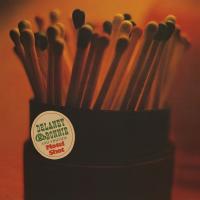Run Out Groove Issues Expanded Delaney & Bonnie And Friends "Motel Shot"
As it turns out, it wasn't recorded in a motel at all! Instead, the album consists of tracks recorded in two places: a recording studio and in Bruce Botnick's living room in the Hollywood Hills the evening before the studio session.
The second album here, consisting of unreleased tracks and alternative takes, was all recorded in the living room, which was about 29' x 20' with a cathedral ceiling. Botnick recalls in the liner note interviews conducted and assembled by Pat Thomas (who should get a Grammy nomination for them [with additional interviews by Matt Block] but probably won't, nor do I imagine he cares) that he used an Ampex 350 two-track machine and a single Neumann SM-69 stereo microphone, recording in the "old style" of moving the people to where the balance was best. Because it was recorded live to two-track there was no way to "fix it in the mix" or do much to enhance what was recorded—not that the spacious, three dimensional recording needed anything to be fixed. Both sessions were recorded "live" with no overdubs.
The history here is as convoluted as it is fascinating. Being astute AnalogPlanet readers you may have asked yourself what was Bruce Botnick doing recording an album for ATCO? Botnick was working for Elektra, which had released the first Delaney & Bonnie album Accept No Substitute in 1969 (though he didn't engineer it) and this was Delaney & Bonnie's 3rd ATCO album (after Delaney & Bonnie & Friends On Tour With Eric Clapton and To Bonnie From Delaney). In fact, this album was recorded for Elektra in November of 1970, but after Delaney threatened Jac Holzman (so the story goes), he dropped them from the label. You'll have to buy the double LP limited to 1231 copies to get the full story.
Pat Thomas and Bill Inglot produced the reissue and did the tape curation, while Bill Inglot gets credit for tape research and mastering. Pre-Mastering for vinyl was by Dave Shultz at D2 mastering. Lacquers were cut by Jeff Powell at Sam Phillips Recording Service. In other words, the vinyl was cut from digital sources created using the original analog master tapes.
You may say "why not cut from tape"? And I may say that too but that's not how it was done. This is the first time the original Motel Shot has been reissued on vinyl and the second LP's worth has never been released at all, so it's not that the tape has been mega-handled but the producers had their reasons and I'm not going to question them, but I'll just tell you how the original cut by George Piros sounds compared to the reissue: the original is warmer and more "organic", while the reissue is a bit "icier" and more modern-sounding, though thankfully it's not been smashed to death or smashed at all as best as I could tell. It's a natural sounding, spacious production to begin with and much if not most of that remains on the reissue.
The second record is, in some ways, more interesting, especially because of how and where it was recorded and because of its more informal musical performances (not that the original is in any way stilted!).
If you don't appreciate gospel rave up type music this is not for you, but otherwise it's music so genuine and heartfelt you can't help but get swept up in the fervor and it's fun listening "in" to try to recognize the assembled musical celebrities. It's mostly Leon on piano and his distinctive voice cuts through, but apparently Nick Hopkins is there too and the credits list Little Feat's Kenny Gradney and a "cast of?" so obviously no one was keeping complete and/or accurate notes.
The gatefold package is a Stoughton Press "Tip-On" jacket and the superb pressing is from Record Industry in The Netherlands (video tour on the AnalogPlanet YouTube channel). This was obviously a labor of love by the Run Out Groove folks and for fans of D&B and the branches of the Mad Dogs and Englishmen offshoot (etc.) this record fills in some missing spaces and puts Motel Shot in its proper historical context. The cool cover is one used for the original release in France. Among the liner note interview's most jarring juxtapositions: Jac Holzman: "Delaney was a scumbag, he'd taken the album he and Bonnie recorded for Elektra and then tried to sell it to the Beatles' Apple Records—Apple was circulating acetates", under which was Bonnie Bramlett: "Jac Holzman at Elektra was a wonderful human being....". Ah, the '60s and early '70s! "That record (the outtakes) is as much reality as you can put on a piece of plastic!"—Bonnie Bramlett. To which I say, "Amen".


